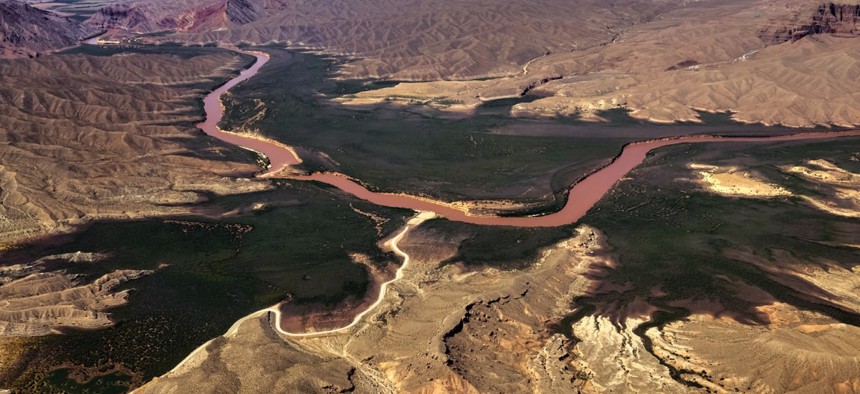Colorado Rolls Out Major Draft Water Plan; Yellowstone Plans to Kill 1,000 Buffalo

Colorado River Philip Bird / Shutterstock.com
Also: Chicago shutters three charter schools, and Phoenix is not the worst of the nation’s ‘urban heat islands’
Here’s some of what we’ve been reading today…
DENVER, Colorado: This is a story that will be closely watched across the West. After years of on-and-off negotiation, the Centennial State, where the great Colorado River springs to life, has unveiled a 480-page draft water plan, reports The Denver Post. In its present form, the plan prioritizes conservation, mainly because it has to: Water supplies in the drought-plagued climate-change era are diminishing, and the population in Colorado, and across the region fed by Colorado water, keeps growing. By 2050, Colorado alone faces projected yearly shortfalls of 163 billion gallons of water. The state’s 5.3 million population is expected to double by then. Patrick Wells, a water engineer with Colorado Springs Utilities, gave a typical no-easy-answers response to the plan: "You cannot meet the water supply gap exclusively with conservation and re-use. It would be irresponsible to have our future water needs met exclusively by the Colorado River Basin. But, if we go the other way, it will result in significant impacts to agriculture.” The draft plan drew more than 30,000 comments from residents. [The Denver Post]
Also in Colorado news: The swank Westin opens Thursday at Denver International Airport, The Denver Post reports. The hotel, which is also a conference center, gallery space and transit hub, has been in the works for years, a striking butterfly-shaped glass and steel structure fitted to the eastern end of the Jeppesen Terminal. In April, light rail trains traveling between Denver and the airport will glide through the hotel into the airport station. The $600 million hotel is part of a wave of airport build-ups going on around the country and the world. It is an early major step in a larger plan to create an airport city around DIA, a so-called aerotopolis, that will include light industry, living space and warehouses. Voters in Denver and Adams Counties in November approved a crucial land-use and tax-sharing deal that green-lighted more development. [The Denver Post]
BILLINGS, Montana: It ain’t easy being a buffalo. Things change, and then they don’t. Yellowstone National Park officials plan to thin the 5,000-strong herd of buffalo that roam the grounds of the park and in the winter migrate in part into Montana, where laws require the federal government takes action to prevent the spread of the disease brucellosis from the wild animals to livestock, reports the Associated Press. Yellowstone is planning to kill 1,000 buffalo; some will be hunted by members of local indian tribes, some by local residents, but most of the buffalo will be slaughtered. Since the 1980s, roughly 6,300 buffalo have been killed. This year, officials plan to kill females and calves to limit reproduction. "The National Park Service has to do this," said Yellowstone spokeswoman Sandy Snell-Dobert. "If there was more tolerance north of the park in Montana for wildlife, particularly bison as well as other wildlife, to travel outside the park boundaries, it wouldn't be an issue." It has been nearly 200 years since some 50 million of the burly, compact, hunched animals roamed the continent in ocean-like herds, filling the Great Plains with the thunder of hooves and storm clouds of dust. [The AP via The Billings Gazette]
CHICAGO, Illinois: More trouble for charter schools. The city board of education voted unanimously to shutter three underperforming charter schools run by small companies, reports The Chicago Tribune. Teachers and parents gave emotional testimony at a board meeting Wednesday night to no avail. The closings will affect about 1,200 students and are the result of a new assessment system that places troubled schools on warning lists and provides plans that the schools must follow to bring up performance. The district reported that the the schools failed to implement the plans. [The Chicago Tribune]
PHOENIX, Arizona: Residents of this sunbaked city are pleased to learn that it does not rank among the top cities in the country on the “urban heat-island” index brought out recently by researchers at the University of Georgia, reports The Arizona Republic. The researchers measured the way heat gets generated and trapped in urban and suburban zones by certain kinds of development, raising the temperature relative to the surrounding area. Tops on the list are the metro areas around Miami; Louisville, Kentucky, Cleveland; and Salt Lake City. Researchers found that dense and contiguous development is one of the problems. Stretches of open space make a big difference. [The Arizona Republic]
LITTLE ROCK, Arkansas: It starts with the Ten Commandments, but it never ends there. At least that’s how it is going in the Natural State, reports The Arkansas Democrat-Gazette. In April, Gov. Asa Hutchinson signed a bill allowing a privately funded monument to the Old Testament Ten Commandments to be placed on the grounds of the state Capitol. In September came a request to place a privately funded Satanic Temple statue on the grounds. Now comes a request to place a privately funded statue of Hindu figure Lord Hanuman. The Capitol Arts and Grounds Commission is considering calling a meeting to weigh the proposals. [The Arkansas Democrat-Gazette]
John Tomasic is a journalist who lives in Boulder, Colorado.
NEXT STORY: Upstate New York Is Betting on More Casinos





